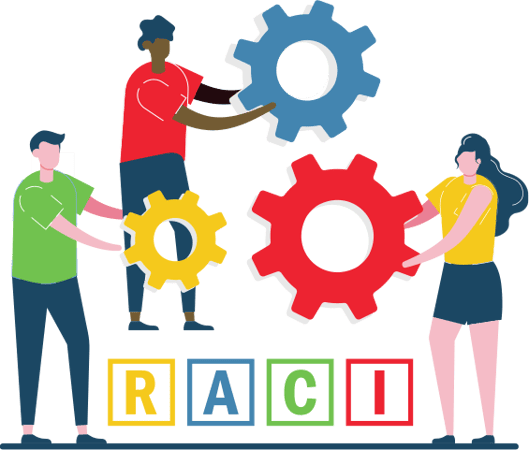The Cross-Functional “Horizontal” Organization
As your career advances, you will likely spend more and more time in the organizational space called the “Horizontal Structure.” This is where project teams, task forces, steering committees, and boards work. The “Vertical Structure” is the one we are all familiar with - the world of hierarchy, department, and silo.
Increasingly, the complex problems we are called on to solve require multi-disciplinary thinking and across-department problem-solving. Welcome to the Horizontal Organization. This is where people from different departments and disciplines come together to do work. In this landscape, it's a lot harder to tell who's boss, harder to know what success looks like, or whether or not success will even be noticed, let alone rewarded
You can tell that things are not going well with projects in the Horizontal Organization when people wonder why things are taking so long. When people stop coming to meetings because their “real” work is more compelling. When sponsors and senior leaders are frustrated because they can’t seem to get project timelines accomplished – or even established. When you start to hear blaming, finger-pointing and conflict between departments instead of collaboration on a complex issue. These are all symptoms that the health of the Horizontal Organization is poor.
It can help a great deal to choose the right project Sponsor.
How to Choose the Right Project Sponsor
At its most basic, a sponsor is a senior leader in the organization who wants something to happen or change. The senior level is important because successful sponsorship requires someone who can really move the organizational chess pieces around – dictate priorities, change the way people allocate their time, give, and take away resources, and set deadlines that people will take seriously. So, the first and most important question to ask about a project or initiative is “Do we have the right sponsor?” The answer is yes, you have the right sponsor if they can do the following:
- The right sponsor is high enough in the organization that they control resources, including the ability to reward performance with meaningful recognition and advancement.
- The right sponsor is deeply committed to the success of the project or initiative – they will come back again and again to check on its progress because they care passionately about getting the problem solved.
- The right sponsor is willing to devote time and attention to the project on a regular basis.
Right away you may notice that #2 and #3 above require the scarcest of resources – time and attention – from a senior leader. Busy executives who are asked to sponsor too many project or change initiatives may put too many balls in the air. The first rule of sponsor success here is focus.
It is true that a lot of advice for leaders in these situations, such as, “Motivate the team” or “Create a sense of urgency” is well-intentioned but vague and hard to implement. Now for some good news: Advice on how to strengthen and maintain a healthy boundary for your team is concrete and easy to understand.
5 Questions Sponsors Should Always Ask
If you have been tapped to sponsor a project or initiative, you play a pivotal role in its success. Here are 5 questions you should ask to get started.
1. How Big Is This Issue?
Before diving into solutions, sponsors must understand the scale and scope of the problem. Ask for data. How many complaints have been logged? What trends are emerging? Are we tracking human error or systemic breakdowns?
This question helps ground the conversation in reality and ensures that the team is solving the right problem. It also sets the tone for evidence-based decision-making, and for making a compelling case that things need to change.
2. What Is the Deadline for Completion?
Cross-functional projects are notorious for missing their deadlines. Often, the people on these teams are doing this work in addition to their “day” (vertical) job, and feel like volunteers. Yet speed is an increasingly critical imperative for today’s organizations. Sponsors have the ability to create a clear roadmap for the project with defined check-in points and deadlines. Regular check-ins with the sponsor helps the team stay focused and builds momentum.
3. Do you want to establish milestones or deadlines or both?
When a group is doing novel, innovative work, you may not know how long things will take. In this case, you are better off creating milestones – which are defined as time-based markers. For example, “Work on this for 6 hours total and come back to me with an update” is an example of a milestone. You want to establish a check in but you may not know how far the group will be able to get in that time period.
Deadlines, of course, are clearer. “Complete Phase One by December 15” tells the team what work needs to be accomplished and by when.
You can establish both milestones and deadlines for your projects, based on what you learn as you go.
Ask: “What are the key deliverables by each checkpoint?” and “When is the final deadline?” This creates urgency and accountability.
4. Who Will Make Decisions for This Project?
In RACI 2.0, the “A” stands for Approver—the person or group who makes a decision. Sponsors can clarify who has decision rights at each stage of the project, which will save a tremendous amount of time for the team. Often, this means negotiating with department leads who are the Sponsor’s peers. Ask: “Who needs to sign off on this phase?” and “Do you want the team to have the R (create a recommendation) or make certain decisions (the A), or offer advice to others (the C for Consult).
5. What Is the Goal—and Is It SMART?
Vague goals like “Improve efficiency” won’t cut it. Sponsors must push for SMART goals: Specific, Measurable, Actionable, Realistic, and Time-bound. For example, “Reduce processing time by 20% within six months” is a goal that drives focus and enables tracking.
This question also opens the door to defining metrics and targets and understanding where to get the data that will determine success.
Sponsorship is not passive. It’s an active leadership role that requires intention, visibility, and strategic support.
Ready to strengthen your organization’s sponsorship skills?





